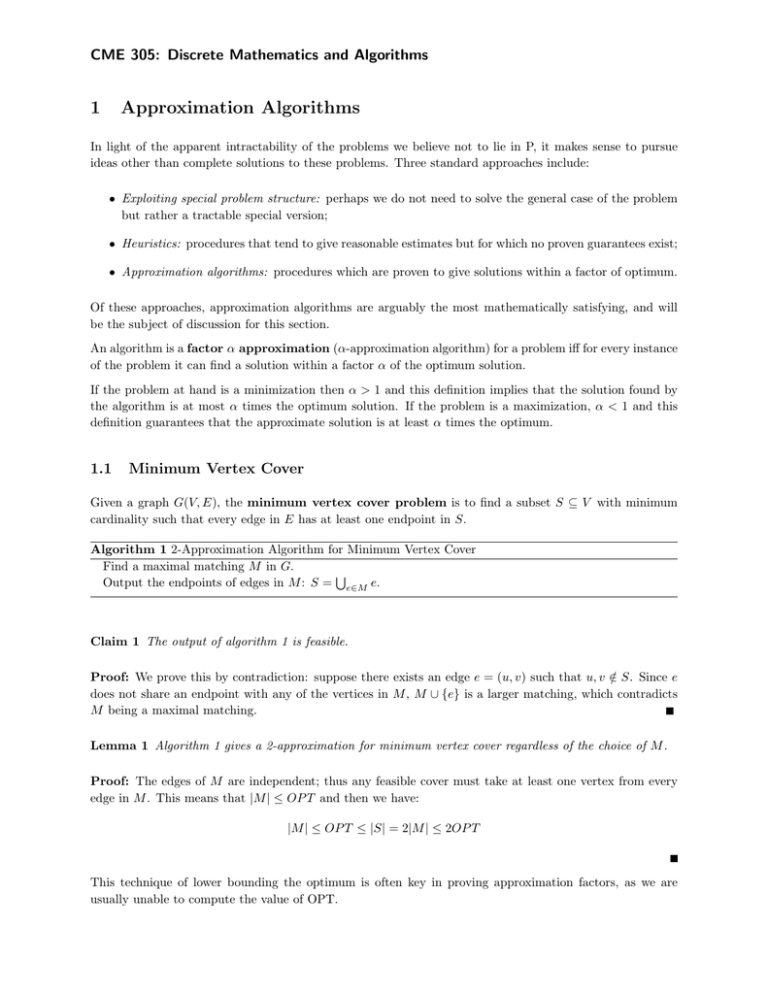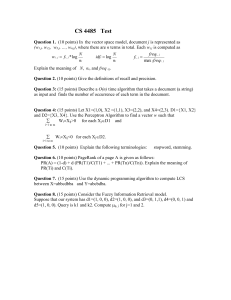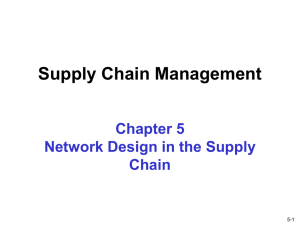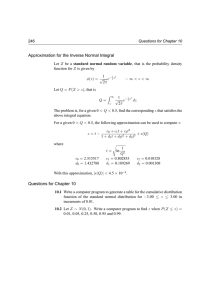Notes
advertisement

CME 305: Discrete Mathematics and Algorithms
1
Approximation Algorithms
In light of the apparent intractability of the problems we believe not to lie in P, it makes sense to pursue
ideas other than complete solutions to these problems. Three standard approaches include:
• Exploiting special problem structure: perhaps we do not need to solve the general case of the problem
but rather a tractable special version;
• Heuristics: procedures that tend to give reasonable estimates but for which no proven guarantees exist;
• Approximation algorithms: procedures which are proven to give solutions within a factor of optimum.
Of these approaches, approximation algorithms are arguably the most mathematically satisfying, and will
be the subject of discussion for this section.
An algorithm is a factor α approximation (α-approximation algorithm) for a problem iff for every instance
of the problem it can find a solution within a factor α of the optimum solution.
If the problem at hand is a minimization then α > 1 and this definition implies that the solution found by
the algorithm is at most α times the optimum solution. If the problem is a maximization, α < 1 and this
definition guarantees that the approximate solution is at least α times the optimum.
1.1
Minimum Vertex Cover
Given a graph G(V, E), the minimum vertex cover problem is to find a subset S ⊆ V with minimum
cardinality such that every edge in E has at least one endpoint in S.
Algorithm 1 2-Approximation Algorithm for Minimum Vertex Cover
Find a maximal matching M in G.
S
Output the endpoints of edges in M : S = e∈M e.
Claim 1 The output of algorithm 1 is feasible.
Proof: We prove this by contradiction: suppose there exists an edge e = (u, v) such that u, v ∈
/ S. Since e
does not share an endpoint with any of the vertices in M , M ∪ {e} is a larger matching, which contradicts
M being a maximal matching.
Lemma 1 Algorithm 1 gives a 2-approximation for minimum vertex cover regardless of the choice of M .
Proof: The edges of M are independent; thus any feasible cover must take at least one vertex from every
edge in M . This means that |M | ≤ OP T and then we have:
|M | ≤ OP T ≤ |S| = 2|M | ≤ 2OP T
This technique of lower bounding the optimum is often key in proving approximation factors, as we are
usually unable to compute the value of OPT.
2
1.2
CME 305: Discrete Mathematics and Algorithms - Lecture 10
Minimum Weight Vertex Cover
Given a graph G(V, E), and a weight function W : V 7→ R+ , the minimum weight vertex cover problem
P
is to find a subset S ⊆ V that covers all the edges and has minimum weight W (S) = v∈S w(v).
We may formulate this problem as an integer program as follows: associate variable xv with node v, and
solve:
X
minimize:
w(v)xv
v∈V
xu + xv ≥ 1, ∀ (u, v) ∈ E
s.t.
xv ∈ {0, 1} ∀ v ∈ V
Solving this integer program is equivalent to solving min weight vertex cover, an NP-complete problem. We
instead attempt to solve a simpler problem for which polynomial-time algorithms exists. We modify the
second constraint to read: 0 ≤ xv ≤ 1 ∀ v ∈ V . This is known as a linear programming (LP) relaxation
of the integer program. It is well known that linear programs can be solved in polynomial time.
Let {x∗v , v ∈ V } be the solution of the LP. We need to convert this fractional solution to an integral one;
bv = 0, otherwise we set x
bv = 1. Note that
we use the following rounding policy: if x∗v < 0 then we set x
{b
xv , v ∈ V } is a feasible solution. Because {x∗v , v ∈ V } is a feasible solution of the LP, x∗v + x∗u ≥ 1, and
thus xv ≥ 1/2 or xu ≥ 1/2 which implies that x
bv + x
bu ≥ 1.
Lemma 2 Let S = {v ∈ V : x
bv = 1}. Then S gives a 2-approximation to min weight vertex cover, i.e.
X
w(v) ≤ 2w(S ∗ )
v∈S
where S ∗ is the optimum solution.
Proof: Since the feasible region of the IP is a subset of the feasible region of the LP, the optimum of the
LP is a lower bound for the optimum of the IP. Moreover, note that our rounding procedure ensures that
x
bv ≤ 2x∗v for all v ∈ V , thus:
X
X
OP TIP ≤ w(S) =
w(v)b
xv ≤ 2
w(v)x∗v = 2OP TLP ≤ 2OP TIP .
v∈V
1.3
v∈V
Job Scheduling
Suppose we have n jobs each of which take time ti to process and m identical machines on which to schedule
their completion. Jobs cannot be split between machines. For a given scheduling, let Aj be the set of jobs
P
assigned to machine j. Let Lj = i∈Aj ti be the load of machine j. The minimum makespan scheduling
problem is to find an assignment of jobs to machines that minimizes the makespan, defined as the maximum
load over all machines (i.e. maxj Lj ).
We consider the following greedy algorithm for this problem which sorts the jobs so that t1 ≥ t2 ≥ ... ≥ tn ,
and iteratively allocates the next job to the machine with the least load.
We note that algorithm 2 need not return an optimal solution. Considering jobs of sizes {3, 3, 2, 2, 2} to be
assigned to two machines we see that it is no better than a 7/6-approximation algorithm. We prove in these
CME 305: Discrete Mathematics and Algorithms - Lecture 10
3
Algorithm 2 Greedy Approximation Algorithm for Job Scheduling
∀j, Aj ← ∅, Tj ← 0
for i = 1 to n do
j ← argmink Tk
Aj = Aj ∪ {i}
Tj = Tj + ti
end for
notes that algorithm 2 has an approximation factor of no worse than 3/2; we leave as an exercise to the
reader to prove that it is actually a 4/3-approximation algorithm.
Let T ∗ denote the optimal makespan. The following two facts are self-evident:
T ∗ ≥ max ti
i
n
T∗ ≥
1 X
ti .
m i
Claim 2 The solution of the greedy makespan algorithm is at most
n
1 X
ti + max ti
i
m i
Proof: Consider machine j with maximum load Tj . Let i be the last job scheduled on machine j. When i
was scheduled, j had the smallest load, so j must have had load smaller than the average load. Then,
n
Tj = (Tj − tj ) + tj ≤
1 X
ti + max ti .
i
m i
This claim shows immediately that algorithm 2 is a 2-approximation algorithm. Slightly more careful analysis
proves α = 3/2.
Lemma 3 The approximation factor of the greedy makespan algorithm is at most 3/2.
Proof: If there are at most m jobs, the scheduling is optimal since we put each job on its own machine. If
there are more than m jobs, then by the pigeonhole principle at least one processor in the optimal scheduling
must get 2 of the first m + 1 jobs. Each of these jobs is at least as big as tm+1 . Thus, T ∗ ≥ 2tm+1 .
Take the output of algorithm 2 and consider machine j assigned maximum load Tj . Let i be the last job
assigned to j. We may assume i > m or else the algorithm’s output is optimal. Since the jobs are sorted,
ti ≤ tm+1 ≤ T ∗ /2 and we have
n
Tj = (Tj − ti ) + ti ≤
1 X
3
ti + ti ≤ T ∗ + T ∗ /2 = T ∗ .
m i=1
2
4
1.4
CME 305: Discrete Mathematics and Algorithms - Lecture 10
Non-Uniform Job Scheduling
Consider a more general version of the minimum makespan scheduling problem in which job i can have
different processing time on different machines. Let tij be the time it takes machine j to process job i. We
P
want to minimize the makespan T = maxj i xij tij where the variable xij ∈ {0, 1} indicates whether job i
is assigned to machine j. We may write this as an integer program with constraints ensuring that each job
is assigned to exactly one machine and that the load of each machine does not exceed T , the makespan.
minimize:
s.t.
T
X
xij = 1
∀i
xij tij ≤ T
∀j
j
X
i
xij ∈ {0, 1}
To approximate a solution to this integer program, one might first try to relax variable xij and let xij ∈ [0, 1],
however, the solution of the corresponding LP may be too far from the solution of the IP. Thus solution of
LP does not serve as a tight lower bound for OPT. For instance, if we have only 1 job, m machines, and
1
t1j = m for every machine j, then OPT= m but the solution of the LP is 1 by assigning x1j = m
.
The maximum ratio of the optimal IP and LP solutions is called the integrality gap. We need to define
the relaxed problem in such a way that the integrality gap is small.
The idea is to ensure that if tij > T we assign xij = 0. We do this by defining a series of feasibility LPs with
a makespan parameter T as follows.
X
xij = 1
∀i
xij tij ≤ T
∀j
j
X
i
0 ≤ xij ≤ 1
∀ i, j
xij = 0
∀ i, j s.t. tij > T
Using binary search we can obtain the smallest value of T , T ∗ , for which the above feasibility linear program
(FLP) has a solution. We outline a procedure for rounding the solution of the FLP with T = T ∗ .
Let G(J, M, E) be a bipartite graph defined on the set of jobs and machines where edge {i, j} between job
i ∈ J and machine j ∈ M has weight xij . Our claim is that this allocation graph can be transformed into a
forest in such a way that the load of every machine remains the same or decreases. Suppose G = (J, M, E)
is not a tree, thus it has cycle c = j1 , i1 , j2 , i2 , . . . , jr , ir , j1 ; suppose we update xi1 j1 to xi1 j1 − 1 , we proceed
around cycle c and update the weight of edges in the following way:
Since the total weight of edges incident to i1 must add up to one, if we decrease xi1 j1 by 1 , we need to
increase xi1 j2 by 1 , thus we update xi1 j2 to xi1 j2 + 1 . Now to keep the load of machine i2 less than or
t
equal to T ∗ , we decrease xi2 j2 by 2 = tii1 jj2 1 , repeating this procedure, we modify the weights keeping the
2 2
constraints satisfied. The only constraint that may become unsatisfied is the load of machine j1 ; we decrease
ti
t
t
jr
the load of j1 by 1 via edge {i1 , j1 } and at the end, we may increase the load by tii1 jj2 tii2 jj3 . . . tr−1
. If
i j
ti1 j2 ti2 j3
ti2 j2 ti3 j3
tir−1 jr
tir jr
2 2
3 3
r r
> 1 we use the simple observation that if we start from {j1 , ir } and go around the cycle
−1
ti
t
t
jr
< 1 thus
in that direction, then we would need to increase the weight of {i1 , j1 } by tii1 jj2 tii2 jj3 . . . tr−1
ir jr
2 2
3 3
∗
the total load of i1 would become less that T .
...
CME 305: Discrete Mathematics and Algorithms - Lecture 10
5
Using the above scheme, we are able to decrease the weight of {i1 , j1 } by keeping the solution feasible.
Repeating this reduction, we can make the weight of one of the edges zero, thus we can remove cycle c. We
obtain our forest by breaking all the cycles.
Suppose now that we have a solution of the FLP with T = T ∗ whose allocation graph is a forest, call it x.
Note that if job i ∈ J is a leaf of the tree with parent j ∈ M , then xij = 1, thus there is no j leaf with
fractional weight. However, we can have fractional edge {i, j} between leaf j ∈ M and its parent i ∈ J.
Suppose i has k leaves j1 , j2 , . . . , jk , we choose one of the leaf machines uniformly at random and assign
job i to it with probability xij . Then we remove i from the graph. We repeat this procedure of assigning
fractional load of a parent to one of its children and removing the job from the graph until all the jobs are
assigned.
Claim 3 The above rounding procedure produces a factor 2 approximation.
Proof: Let OP T be the makespan of the optimal assignment and let T ∗ be the minimum value of T found
using binary search on FLP. Then, T ∗ ≤ OP T since the FLP is clearly feasible using the optimal assignment.
x is a feasible solution therefore load of each machine is at most T ∗ . During the rounding procedure, we
add the load of at most one job to each machine because a node i can only have one parent in the forest
P
G. Any machine j’s load before this addition is i∈J xij tij ≤ T ∗ , so the new load of machine j is less than
2T ∗ . Hence, the final makespan is at most 2T ∗ .
1.5
Maximum Satisfiability
We return to the setting of boolean formulas and consider a problem related to satisfiability: for a given
formula in CNF, what is the maximum number of its clauses that can be satisfied by assigning truth values
to its variables? More concretely, suppose we have n variables x1 , ..., xn and m clauses C1 , ..., Cm where
_
_
Ci =
xi ∨
x̄i .
i∈Si−
i∈Si+
The maximum satisfiability problem is to find the maximum number of clauses that may be satisfied
by an assignment x.
We first propose a simple randomized algorithm to approximate a solution to this problem. Set each xi
independently to be 0 or 1 with probability 1/2. Then the probability that any Ci is satisfied is 1 − 2|Ci | .
Pm
If we let Zi denote the event that clause Ci is satisfied by this random assignment and Z = i=1 Zi be the
total number of satisfied clauses, we may compute:
E[Z] =
m
X
i=1
E[Zi ] =
m X
1 − 2|Ci | .
i=1
In the case that all of our clauses are large, i.e. |Ci | ≥ K for each i, then this randomized algorithm has an
approximation ratio of ≥ 1 − 2−K in expectation:
m(1 − 2−K ) ≤ E[Z] ≤ OP T ≤ m.
An expected approximation ratio is sometimes undesirable because it does not shed much light on the
probability that the randomized algorithm returns a good solution. Concentration inequalities can help us
estimate such probabilities, but in some cases we may do even better. This algorithm may be derandomized
using conditional expectation as follows.
6
CME 305: Discrete Mathematics and Algorithms - Lecture 10
Algorithm 3 Derandomized Approximation Algorithm for Maximum Satisfiability
for i = 1 to n do
Compute 21 E[Z | xi = 1, xi−1 , ..., x1 ] and 12 E[Z | xi = 0, xi−1 , ..., x1 ].
Set xi = 1 if the first expression is larger than the second, set xi = 0 otherwise.
end for
return x
For motivation, we consider the first step of the algorithm. Note that
E[Z] =
1
1
E[Z | x1 = 1] + E[Z | x1 = 0].
2
2
Both terms on the right hand side may be computed simply by summing over all clauses the probability
that Ci is satisfied given the information on x1 . The equation above implies that E[Z | x1 = 1] ≥ E[Z]
or E[Z | x1 = 0] ≥ E[Z]. Thus if we choose the greater expectation in each step of the algorithm, we will
deterministically build up an assignment x such that
E[Z|x] ≥ E[Z] ≥ m(1 − 2−K )
where E[Z|x] is no longer an expectation, but merely an evaluation.
The approximation ratio of algorithm 3 depends on all of the clauses having K or more variables. We present
a different algorithm for dealing with the possibility that some of the clauses may be small. It is based on
the now familiar concept of LP relaxation. We write down an integer program for maximum satisfiability.
maximize:
m
X
qi
i=1
s.t.
qi ≤
X
yj +
j∈Si+
X
(1 − yj )
∀i
j∈Si−
qi , yj ∈ {0, 1}
∀ i, j
The variables qi correspond to the truth value of each clause Ci , and the variables yj correspond to the
values of each boolean variable xi . We relax the last condition to be 0 ≤ qi , yj ≤ 1 in order to get a linear
program.
Algorithm 4 LP Relaxation Algorithm for Maximum Satisfiability
Solve the LP given above.
for j = 1 to n do
1 : with probability yj∗
Independently set xj =
0 : with probability 1 − yj∗
end for
In order to analyze algorithm 4 we consider the probability that a particular clause is satisfied; WLOG we
CME 305: Discrete Mathematics and Algorithms - Lecture 10
7
consider C1 = x1 ∨ ... ∨ xk . We have q1∗ = min{y1∗ + ... + yk∗ , 1} and by the AM-GM inequality:
P r[C1 ] = 1 −
k
Y
(1 − yj∗ )
j=1
k
k
X
1
(1 − yj∗ )
≥1−
k j=1
k
q∗
≥1− 1− 1
k
k !
1
≥ q1 1 − 1 −
k
≥ q1 (1 − 1/e)
This last line implies, through the linearity of expectation, that this rounding procedure gives a (1 − 1/e)approximation for maximum satisfiability regardless of the size of the smallest clause. Algorithm 4 may also
be derandomized by the method of conditional expectations.
These two derandomized algorithms may be combined to give a factor 3/4 approximation algorithm for
maximum satisfiability. We simply run both algorithms on a given problem instance and output the better
of the two assignments. This procedure itself may be viewed as a derandomization of an algorithm that flips
a fair coin to decide which randomized sub-algorithm to run. That algorithm has approximation factor 3/4:
|Ci | !!
m
m
X
X
1
1
−|Ci |
(1 − 2
)+ 1− 1−
≥ (3/4)m.
E[Z] =
E[Zi ] ≥
2
|Ci |
i=1
i=1




